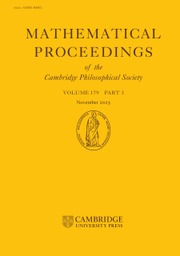Crossref Citations
This article has been cited by the following publications. This list is generated based on data provided by
Crossref.
Kleinman, R. E.
and
Roach, G. F.
1974.
Boundary Integral Equations for the Three-Dimensional Helmholtz Equation.
SIAM Review,
Vol. 16,
Issue. 2,
p.
214.
Ahner, John F.
and
Hsiao, George C.
1976.
On the Two-Dimensional Exterior Boundary-Value Problems of Elasticity.
SIAM Journal on Applied Mathematics,
Vol. 31,
Issue. 4,
p.
677.
1977.
Null field approach to scalar diffraction I. General method.
Philosophical Transactions of the Royal Society of London. Series A, Mathematical and Physical Sciences,
Vol. 287,
Issue. 1339,
p.
45.
Ursell, F.
1978.
On the exterior problems of acoustics: II.
Mathematical Proceedings of the Cambridge Philosophical Society,
Vol. 84,
Issue. 3,
p.
545.
Colton, David
1978.
The Scattering of Acoustic Waves by a Spherically Stratified Medium and an Obstacle.
SIAM Journal on Mathematical Analysis,
Vol. 9,
Issue. 5,
p.
935.
MEYER, W.
BELL, W.
and
ZINN, B.
1978.
Prediction of the sound field radiated from axisymmetric surfaces.
Colton, David
1978.
Differential Equations and Applications, Proceedings of the Third Scheveningen Conference on Differential Equations.
Vol. 31,
Issue. ,
p.
181.
Wilton, D. T.
1978.
Acoustic radiation and scattering from elastic structures.
International Journal for Numerical Methods in Engineering,
Vol. 13,
Issue. 1,
p.
123.
Mattioli, F.
1980.
Numerical instabilities of the integral approach to the interior boundary‐value problem for the two‐dimensional Helmholtz equation.
International Journal for Numerical Methods in Engineering,
Vol. 15,
Issue. 9,
p.
1303.
Graham, Ivan G.
1980.
The application and numerical solution of integral equations.
p.
75.
Michalski, Krzysztof A.
1981.
BIBLIOGRAPHY OF THE SINGULARITY EXPANSION METHOD AND RELATED TOPICS.
Electromagnetics,
Vol. 1,
Issue. 4,
p.
493.
Kress, Rainer
1981.
Ordinary and Partial Differential Equations.
Vol. 846,
Issue. ,
p.
210.
Yaghjian, Arthur D.
1981.
Augmented electric‐ and magnetic‐field integral equations.
Radio Science,
Vol. 16,
Issue. 6,
p.
987.
Angell, T. S.
and
Kleinman, R. E.
1982.
Generalized exterior boundary-value problems and optimization for the Helmholtz equation.
Journal of Optimization Theory and Applications,
Vol. 37,
Issue. 4,
p.
469.
Kress, R.
1982.
Integralgleichungsmethoden bei direkten und inversen Randwertproblemen aus der Theorie akustischer und elektromagnetischer Schwingungen.
ZAMM - Journal of Applied Mathematics and Mechanics / Zeitschrift für Angewandte Mathematik und Mechanik,
Vol. 62,
Issue. 5,
Bayliss, Alvin
Gunzburger, Max
and
Turkel, Eli
1982.
Boundary Conditions for the Numerical Solution of Elliptic Equations in Exterior Regions.
SIAM Journal on Applied Mathematics,
Vol. 42,
Issue. 2,
p.
430.
Colton, David
1982.
Runge’s Theorem and Far Field Patterns for the Impedance Boundary Value Problem in Acoustic Wave Propagation.
SIAM Journal on Mathematical Analysis,
Vol. 13,
Issue. 6,
p.
970.
Colton, David
1982.
Ordinary and Partial Differential Equations.
Vol. 964,
Issue. ,
p.
143.
Wendland, W. L.
1983.
Theoretical Acoustics and Numerical Techniques.
p.
135.
Dravinski, Marijan
1983.
Ground motion amplification due to elastic inclusions in a half‐space.
Earthquake Engineering & Structural Dynamics,
Vol. 11,
Issue. 3,
p.
313.

